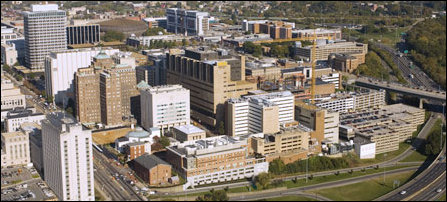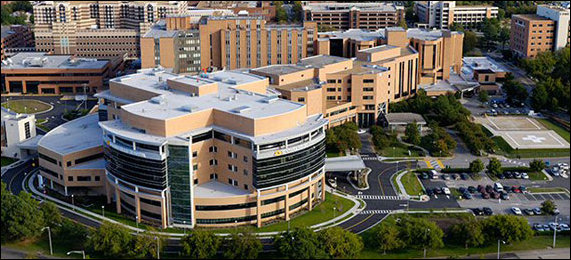by James A. Bacon
U.S. News & World-Report has issued its 2015-2016 ranking of the nation’s “best hospitals,” and Virginia has four hospitals with at least one adult specialty receiving a “national” ranking. The online publishing company bills the ranking as a tool to help patients select hospitals that can best treat complex illnesses. But it also prompts questions about the role of hospitals as agents of economic development.
Hospitals are major employers and generators of economic activity in every community they serve. While some hospitals cater to local markets exclusively, some have such a reputation for excellence in certain specialty practices, from cancer to heart disease, that they draw patients from around the state, the nation or even the world. To the extent that a hospital draws patients from elsewhere, it can be said to be “exporting” services and making a contribution to local jobs and economic activity.
Thus, Massachusetts General, rated the best hospital this year, excels in everyone of the 16 specialties covered by U.S. News & World-Report and three pediatric specialties. The hospital employs 2,889 doctors, many of whom are highly compensated specialists, not to mention a host of nurses, technicians, administrators and others. Its reputation as one of the best research hospitals in the world brings in “thousands” of international patients — so many that the hospital maintains a dedicated “international patient center.” No wonder that Mass General is an anchor of the Boston regional economy.
Accepting the proposition that hospitals can be big contributors to regional economies over and above their contribution to public health, how do Virginia’s hospitals shake up? Here’s the score:
Virginia Commonwealth University Medical Center
National ranking in 3 adult specialties, one pediatric specialty
Doctors: 454
Sentara Norfolk General
National ranking in 2 adult specialties
Doctors: 694
Inova Fairfax
National ranking in 1 adult specialty, two pediatric specialties
Doctors: 1,689
University of Virginia Medical Center
National ranking in 1 adult specialty, 4 pediatric specialties
Doctors: 609
How significant are those rankings? That’s hard to say. There are nearly 5,000 hospitals across the United States. U.S. News & World-Report uses a methodology that combines metrics such as hospital volume and risk-adjusted survival rates for complex cases and supplements them with a physician survey of hospital reputations. To be awarded a “national” ranking, a hospital must score within the top 50. In other words, that puts VCU in the top 1% for three adult specialties and one pediatric specialty. The publication does not publish the numbers behind the scores, so there is no way to tell if VCU’s specialties rank No. 1 in the country or No. 50.
U.S. News and World-Report focuses on 16 adult specialties. With 50 hospitals recognized for each specialty, a total of 800 total hospital specialties are recognized. Only seven of those are located in Virginia. To put that in perspective, Virginia has 2.6% of the nation’s population, 3.3% of its GDP but only 0.9% of its nationally ranked hospital specialties.
These are very rough numbers that are undoubtedly subject to criticism. But they suggest to me that Virginia’s hospitals are an under-performing economic sector. If hospitals achieved a level of excellence commensurate with Virginia’s population and GDP, there would be far more centers of excellence in the state, along with more highly compensated doctors, nurses and technicians employed.
That’s not meant to be a put-down of Virginia’s hospitals. The ability to expertly handle highly complex medical cases does not tell us much about the ability to handle routine cases. It doesn’t tell us how much the hospitals charge for their services or whether they’re providing value for the dollar. It doesn’t mean that Virginia hospitals aren’t serving their community. What the numbers mean is that Virginia is missing out on an economic development opportunity to provide services outside the community.
What U.S. News & World-Report does not tell us, and I don’t know, is what it takes to become a national-class hospital. I suspect that it takes a long time to build a top oncology or heart program, so longevity is probably a requirement. It also helps to live in a community that can afford to pay the high salaries of top medical talent. And it probably helps to have wealthy philanthropists willing to endow new buildings, medical school professorships and R&D. Undoubtedly, there are other factors of which I am unaware. I think it would be interesting to know what the key drivers are, and whether building institutions known for their medical excellence is something that communities can influence through government policy and/or philanthropic endeavors.
Virginians still think of economic development either as big game hunting for corporate investments or venture capital-driven business creation. But economic development comes in many forms, and hospitals are one. It strikes me that this is an area that warrants more attention here in the Old Dominion.




